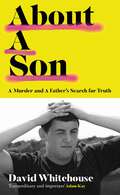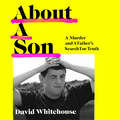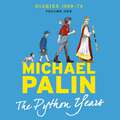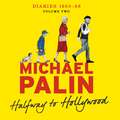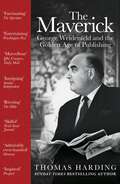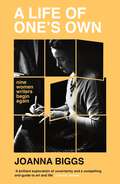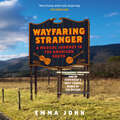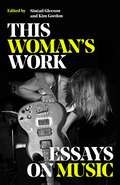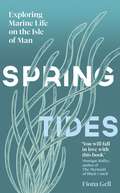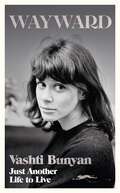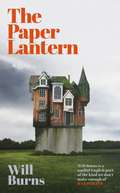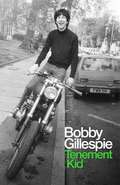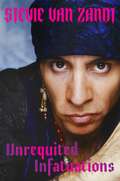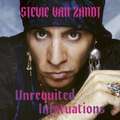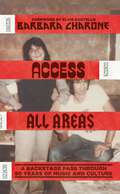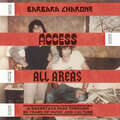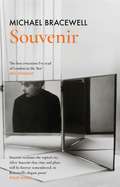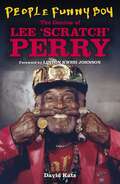- Table View
- List View
About A Son: A Murder and A Father’s Search for Truth
by David WhitehouseAs heard on the HOW TO FAIL podcast with Elizabeth Day'I was utterly floored by the emotional depth of About A Son - a book that reaches so deeply into the human experience that to read it is to be forever changed. It is an unflinching examination of grief, a painstaking deconstruction of injustice and a dispatch from the frontiers of the human heart' Elizabeth DayOn the evening of Halloween in 2015, Morgan Hehir was walking with friends close to Nuneaton town centre when they were viciously attacked by a group of strangers. Morgan was stabbed, and died hours later in hospital. He was twenty years old and loved making music with his band, going to the football with his mates, having a laugh; a talented graffiti artist who dreamed of moving away and building a life for himself by the sea.From the moment he heard the news, Morgan's father Colin Hehir began to keep an extraordinary diary. It became a record not only of the immediate aftermath of his son's murder, but also a chronicle of his family's evolving grief, the trial of Morgan's killers, and his personal fight to unravel the lies, mistakes and cover-ups that led to a young man with a history of violence being free to take Morgan's life that night.Inspired by this diary, About a Son is a unique and deeply moving exploration of love and loss and a groundbreaking work of creative non-fiction. Part true crime, part memoir, it tells the story of a shocking murder, the emotional repercussions, and the failures that enabled it to take place. It shows how grief affects and changes us, and asks what justice means if the truth is not heard. It asks what can be learned, and where we go from here.
Busy Being Free: A Lifelong Romantic is Seduced by Solitude
by Emma Forrest'A staggering piece of writing' Nigella Lawson'It's woken me up' Minnie Driver, author of Managing Expectations'The most delicious memoir that kept me in bed all day' Sophie Heawood, author of The Hungover GamesWhat happens when your story doesn't end the way you thought it would? When the dream life you have been working towards becomes something you must walk away from? When you swap a Hollywood marriage and a LA mansion with waterside views, for a little attic flat shared only with your daughter, beneath the star-filled sky of deepest North London? When you find yourself not lonely, but elated - elated to be alone with yourself, who you genuinely thought you might never get to see again? When, after a life guided by romantic obsession, you decide to turn your back not only on marriage, but all romantic and sexual attachments?
Busy Being Free: A Lifelong Romantic is Seduced by Solitude
by Emma Forrest'A staggering piece of writing' Nigella Lawson'It's woken me up' Minnie Driver, author of Managing Expectations'The most delicious memoir that kept me in bed all day' Sophie Heawood, author of The Hungover GamesWhat happens when your story doesn't end the way you thought it would? When the dream life you have been working towards becomes something you must walk away from? When you swap a Hollywood marriage and a LA mansion with waterside views, for a little attic flat shared only with your daughter, beneath the star-filled sky of deepest North London? When you find yourself not lonely, but elated - elated to be alone with yourself, who you genuinely thought you might never get to see again? When, after a life guided by romantic obsession, you decide to turn your back not only on marriage, but all romantic and sexual attachments?
About A Son: A Murder and A Father’s Search for Truth
by David WhitehouseAs heard on the HOW TO FAIL podcast with Elizabeth Day'I was utterly floored by the emotional depth of About A Son - a book that reaches so deeply into the human experience that to read it is to be forever changed. It is an unflinching examination of grief, a painstaking deconstruction of injustice and a dispatch from the frontiers of the human heart' Elizabeth DayOn the evening of Halloween in 2015, Morgan Hehir was walking with friends close to Nuneaton town centre when they were viciously attacked by a group of strangers. Morgan was stabbed, and died hours later in hospital. He was twenty years old and loved making music with his band, going to the football with his mates, having a laugh; a talented graffiti artist who dreamed of moving away and building a life for himself by the sea.From the moment he heard the news, Morgan's father Colin Hehir began to keep an extraordinary diary. It became a record not only of the immediate aftermath of his son's murder, but also a chronicle of his family's evolving grief, the trial of Morgan's killers, and his personal fight to unravel the lies, mistakes and cover-ups that led to a young man with a history of violence being free to take Morgan's life that night.Inspired by this diary, About a Son is a unique and deeply moving exploration of love and loss and a groundbreaking work of creative non-fiction. Part true crime, part memoir, it tells the story of a shocking murder, the emotional repercussions, and the failures that enabled it to take place. It shows how grief affects and changes us, and asks what justice means if the truth is not heard. It asks what can be learned, and where we go from here.
The Python Years: Diaries 1969-1979 Volume One
by Michael PalinMichael Palin's bestselling diaries before, during and after Monty Python.Michael Palin's diaries begin when he was newly married and struggling to make a name for himself in the world of television comedy. But Monty Python was just around the corner . . .Enjoying an unlikely cult status early on, the Pythons then proceeded to tour the USA and Canada. As their popularity grew, so Palin relates how the group went their separate ways, later to re-form for stage shows and the celebrated films THE HOLY GRAIL and LIFE OF BRIAN. Living through the three-day week and the miners strike, and all the trials of a peripatetic life are also essential ingredients of these perceptive and funny diaries.
Halfway To Hollywood: Diaries 1980-1988 (Volume Two)
by Michael PalinMichael Palin's bestselling diaries of the 1980s.After a live performance at the Hollywood Bowl, The Pythons made their last performance together in 1983 in the hugely successful MONTY PYTHON'S MEANING OF LIFE. Writing and acting in films and television then took over much of Michael's life, culminating in the smash hit A FISH CALLED WANDA (for which he won a BAFTA for Best Supporting Actor), and the first of his seven celebrated television journeys for the BBC. He co-produced, wrote and played the lead in THE MISSIONARY opposite Maggie Smith, who also appeared with him in A PRIVATE FUNCTION, written by Alan Bennett. Such was his fame in the US, he was enticed into once again hosting the enormously popular show Saturday Night Live, in one edition of which his mother makes a highly successful surprise guest appearance. He filmed several journeys for television and became chairman of the pressure group, Transport 2000. His family remains a constant as his and Helen's children enter their teens.
The Maverick: George Weidenfeld and the Golden Age of Publishing
by Thomas HardingBorn into a Jewish family in Vienna in 1919, George Weidenfeld fled to England in 1938 to escape the Nazi regime. There he began a career in publishing that would make him one of the most influential figures in the industry. Over the course of his long and illustrious career he championed some of the most important voices of the twentieth century, from Vladimir Nabokov, Mary McCarthy and Saul Bellow to Harold Wilson, Isaiah Berlin and Henry Kissinger.But what do we know about the man himself? Was he, as described by some, the 'greatest salesperson', 'the world's best networker', 'the publisher's publisher' and 'a great intellectual'? Was his lifelong effort to be the world's most famous host a cover for his desperate loneliness? Who, in fact, was the real George Weidenfeld and how did he rise so successfully within the ranks of London and New York society? Providing a full, unvarnished and at times difficult history of this complex man, this first biography of a titan of culture is also a story of resilience, determination and the power of ideas to shape history.
A Life of One's Own: Nine Women Writers Begin Again
by Joanna BiggsI took off my wedding ring - a gold band with half a line of 'Morning Song' by Sylvia Plath etched inside - and for weeks afterwards, my thumb would involuntarily reach across my palm for the warm bright circle that had gone. I didn't throw the ring into the long grass, like women do in the movies, but a feeling began bubbling up nevertheless, from my stomach to my throat: it could fling my arms out. I was free.A few years into her marriage and feeling societal pressure to surrender to domesticity, Joanna Biggs found herself longing for a different kind of existence. Was this all there was? She divorced without knowing what would come next.Newly untethered, Joanna returned to the free-spirited writers of her youth and was soon reading in a fever - desperately searching for evidence of lives that looked more like her own, for the messiness and freedom, for a possible blueprint for intellectual fulfillment.In A Life of One's Own, Mary Wollstonecraft, George Eliot, Zora Neale Hurston, Virginia Woolf, Simone de Beauvoir, Sylvia Plath, Toni Morrison, and Elena Ferrante are all taken down from their pedestals, their work and lives seen in a new light. Joanna wanted to learn more about the conditions these women needed to write their best work, and how they addressed the questions she herself was struggling with: Is domesticity a trap? Is life worth living if you have lost faith in the traditional goals of a woman? Why is it so important for women to read one another?This is a radical and intimate examination of the unconventional paths these women took - their pursuits and achievements but also their disappointments and hardships. And in exploring the things that gave their lives the most meaning, we find fuel for our own singular intellectual paths.
My Unapologetic Diaries
by Joan Collins'Wonderfully rich and mesmerising' William Boyd'As brutal, withering and funny as you'd expect' Julian Clary'Fabulously entertaining, impossibly glamorous, and utterly irresistible' Piers Morgan'A treat from start to finish' Elizabeth Hurley***Joan Collins has been a diarist from the age of twelve, writing enthusiastically over the years. She dictated most of these entries in real time into a mini-tape recorder at the end of the day, and now she is spilling the beans - well, nearly all of them. What you will discover was written when Joan 'felt like it' between 1989 and 2009. Whether it is an encounter with a superstar or a member of the Royal Family, or her keen and honest insights into other celebrities at dinner parties and events, Joan is honest and unapologetic.Taking us on a dazzling tour around the globe - from exclusive restaurants in Los Angeles to the glittering beaches of St Tropez, from dinner parties in London to galas in New York City - some of the characters you will meet in these pages include Rod Stewart, Princess Margaret, Donald Trump, Michael Caine, Princess Diana, Elizabeth Taylor, Rupert Everett, Roger Moore, Shirley MacLaine, Andrew Lloyd Webber and many more. Her diaries are intimate and witty, and they pull no punches, with NO apologies to anyone mentioned in them!
Wayfaring Stranger: A Musical Journey in the American South
by Emma JohnCan you feel nostalgic for a life you've never known?Suffused with her much-loved warmth and wit, Emma John's memoir follows her moving and memorable journey to master one of the hardest musical styles on earth - and to find her place in an alien world.Emma had fallen out of love with her violin when a chance trip to the American South introduced her to bluegrass music. Classically trained, highly strung and wedded to London life, Emma was about as country as a gin martini. So why did it feel like a homecoming?Answering that question takes Emma deep into the Appalachian mountains, where she uncovers a hidden culture that confounds every expectation - and learns some emotional truths of her own.
This Woman's Work: Essays on Music
by VariousThis Woman's Work: Essays on Music is edited by Kim Gordon and Sinéad Gleeson and features contributors Anne Enright, Fatima Bhutto, Jenn Pelly, Rachel Kushner, Juliana Huxtable, Leslie Jamison, Liz Pelly, Maggie Nelson, Margo Jefferson, Megan Jasper, Ottessa Moshfegh, Simone White, Yiyun Li and Zakia Sewell.Published to challenge the historic narrative of music and music writing being written by men, for men, This Woman's Work seeks to confront the male dominance and sexism that have been hard-coded in the canons of music, literature, and film and has forced women to fight pigeon-holing or being side-lined by carving out their own space. Women have to speak up, to shout louder to tell their story - like the auteurs and ground-breakers featured in this collection, including: Anne Enright on Laurie Anderson; Megan Jasper on her ground-breaking work with Sub Pop; Margo Jefferson on Bud Powell and Ella Fitzgerald; and Fatima Bhutto on music and dictatorship.This Woman's Work also features writing on the experimentalists, women who blended music and activism, the genre-breakers, the vocal auteurs; stories of lost homelands and friends; of propaganda and dictatorships, the women of folk and country, the racialised tropes of jazz, the music of Trap and Carriacou; of mixtapes and violin lessons.
Spring Tides: Exploring Marine Life on the Isle of Man
by Fiona Gell'This is my earliest memory. I am three years old and I sit in the bottom of my great-uncle's pot boat and take off the bands from the lobsters' claws. The deepest of blues, they creak over the bilges with robotic limbs towards my father's bare feet as he rows. Over the scent of the herring bait I can smell the fresh, sweet smell of wrack on the shore. This book has come out of over twenty years of studying the sea and trying to protect it, and a lifetime of loving our other world beneath waves.'In Spring Tides, marine biologist Fiona Gell tells the story of a pioneering project to create the very first marine nature reserve on the Isle of Man. Growing up in a traditional fishing family on the island, Fiona spent her time on her grandfather's boat, listening to stories from the local fishermen and combing the beach for mermaid's purses and whelks' eggs. She developed a lifelong love of the sea and Manx culture, and on her return to the island after twelve years away studying marine life, she led a three-year-long struggle to protect an area called Ramsey Bay and the precious emerald green eelgrass forests which grew there. With scientific insight and spellbinding prose she perfectly captures the wonder of island life, from the intricate beauty of bright pink maerl, to the enormity of giant basking sharks spotted off the cliffs of the bay. This beautiful story from a small island reveals the transformative power of the sea, and the importance of protecting it for future generations.
Wayward: Just Another Life to Live
by Vashti Bunyan'Magical and transporting . . . Wayward proves that Bunyan has lived the best possible life, on her own idiosyncratic terms'Maggie O'Farrell'A gorgeous account of outsiderness and survival: a map of how to live outside the boundaries and of striving for an authentic artistic life. A quietly defiant and moving work' Sinéad Gleeson'An epic in miniature . . . I loved - and lived - every sentence' Benjamin MyersIn 1968, Vashti Bunyan gave up everything and everybody she knew in London to take to the road with a horse, wagon, dog, guitar and her then partner. They made the long journey up to the Outer Hebrides in an odyssey of discovery and heartbreak, full of the joy of freedom and the trudge of everyday reality, sleeping in the woods, fighting freezing winters and homelessness. Along the way, Vashti wrote the songs that would lead to the recording of her 1970's album Just Another Diamond Day, the lilting lyrics and guitar conveying innocent wonder at the world around her, whilst disguising a deeper turmoil under the surface. From an unconventional childhood in post-war London, to a fledgling career in mid-sixties pop - recording a single written by Mick Jagger and Keith Richards - to the despair and failure to make any headway with her own songs, she rejected the music world altogether and left it all behind. After retreating to a musical wilderness for thirty years, the rediscovery of her recordings in 2000 brought Vashti a second chance to write, record and perform once more. One of the great hippie myths of the 1960s, Wayward, Just Another Life to Live, rewrites the narrative of a barefoot girl on the road to describe a life lived at full tilt from the first, revealing what it means to change course and her emotional struggle, learning to take back control of her own life.
Wayward: Just Another Life to Live
by Vashti Bunyan'Magical and transporting . . . Wayward proves that Bunyan has lived the best possible life, on her own idiosyncratic terms'Maggie O'Farrell'A gorgeous account of outsiderness and survival: a map of how to live outside the boundaries and of striving for an authentic artistic life. A quietly defiant and moving work' Sinéad Gleeson'An epic in miniature . . . I loved - and lived - every sentence' Benjamin MyersIn 1968, Vashti Bunyan gave up everything and everybody she knew in London to take to the road with a horse, wagon, dog, guitar and her then partner. They made the long journey up to the Outer Hebrides in an odyssey of discovery and heartbreak, full of the joy of freedom and the trudge of everyday reality, sleeping in the woods, fighting freezing winters and homelessness. Along the way, Vashti wrote the songs that would lead to the recording of her 1970's album Just Another Diamond Day, the lilting lyrics and guitar conveying innocent wonder at the world around her, whilst disguising a deeper turmoil under the surface. From an unconventional childhood in post-war London, to a fledgling career in mid-sixties pop - recording a single written by Mick Jagger and Keith Richards - to the despair and failure to make any headway with her own songs, she rejected the music world altogether and left it all behind. After retreating to a musical wilderness for thirty years, the rediscovery of her recordings in 2000 brought Vashti a second chance to write, record and perform once more. One of the great hippie myths of the 1960s, Wayward, Just Another Life to Live, rewrites the narrative of a barefoot girl on the road to describe a life lived at full tilt from the first, revealing what it means to change course and her emotional struggle, learning to take back control of her own life.
The Paper Lantern
by Will Burns'Will Burns is a soulful English poet of the kind we don't make enough of' MAX PORTER'Hugely affecting and timely' LUKE TURNER'A boldly struck chord, one that contains many of the dissonances, but also the harmonies, found in England today' CHRIS POWERIn THE PAPER LANTERN, a single speaker charts and interrogates the shifts in mood and understanding that have defined a surreal, transformative period in both his own history and that of the surrounding area. Set in a shuttered pub - The Paper Lantern - in a village in the very middle of the country adjacent to the Chequers estate, the narrator embarks on a series of walks in the Chiltern Hills, which become the landscape for evocations of a past scarred with trauma and a present lacking compass. From local raves in secret valleys and the history of landmarks such as Halton House, to the fallout of the lockdown period, climate change and capitalism, THE PAPER LANTERN creates a tangible, lived-in, complicated rendering of a place.
Tenement Kid: Rough Trade Book of the Year
by Bobby GillespieTenement Kid is Bobby Gillespie's story up to the recording and release of the album that has been credited with 'starting the 90's', Screamadelica.Born into a working class Glaswegian family in the summer of 1961, Bobby's memoirs begin in the district of Springburn, soon to be evacuated in Edward Heath's brutal slum clearances. Leaving school at 16 and going to work as a printers' apprentice, Bobby's rock n roll epiphany arrives like a bolt of lightning shining from Phil Lynott's mirrored pickguard at his first gig at the Apollo in Glasgow. Filled with 'the holy spirit of rock n roll' his destiny is sealed with the arrival of the Sex Pistols and punk rock which to Bobby, represents an iconoclastic vision of class rebellion and would ultimately lead to him becoming an artist initially in the Jesus and Mary Chain then in Primal Scream.Structured in four parts, Tenement Kid builds like a breakbeat crescendo to the final quarter of the book, the Summer of Love, Boys Own parties, and the fateful meeting with Andrew Weatherall in an East Sussex field. As the '80s bleed into the '90s and a new kind of electronic soul music starts to pulse through the nation's consciousness, Primal Scream become the most innovative British band of the new decade, representing a new psychedelic vanguard taking shape at Creation Records.Ending with the release of Screamadelica and the tour that followed in the autumn, Tenement Kid is a book filled with the joy and wonder of a rock n roll apostle who would radically reshape the future sounds of fin de siècle British pop. Published thirty years after the release of their masterpiece, Bobby Gillespie's memoir cuts a righteous path through a decade lost to Thatcherism and saved by acid house.
Unrequited Infatuations: A Memoir
by Stevie Van Zandt'A wonderfully original take on a Rock and Roll autobiography' Paul McCartney'An inimitable Rock 'n' Roll life told as boldly as it was lived' Bruce SpringsteenWhat story begins in a bedroom in suburban New Jersey in the early '60s, unfolds on some of the country's largest stages, and then ranges across the globe, demonstrating over and over again how Rock and Roll has the power to change the world for the better? This story.The first true heartbeat of UNREQUITED INFATUATIONS is the moment when Stevie Van Zandt trades in his devotion to the Baptist religion for an obsession with Rock and Roll. Groups like the Beatles and the Rolling Stones created new ideas of community, creative risk, and principled rebellion. They changed him forever. While still a teenager, he met Bruce Springsteen, a like-minded outcast/true believer who became one of his most important friends and bandmates. As Miami Steve, Van Zandt anchored the E Street Band as they conquered the Rock and Roll world.And then, in the early '80s, Van Zandt stepped away from E Street to embark on his own odyssey. He refashioned himself as Little Steven, a political songwriter and performer, fell in love with Maureen Santoro who greatly expanded his artistic palette, and visited the world's hot spots as an artist/journalist to not just better understand them, but to help change them. Most famously, he masterminded the recording of "Sun City," an anti-apartheid anthem that sped the demise of South Africa's institutionalized racism and helped get Nelson Mandela out of prison.By the '90s, Van Zandt had lived at least two lives-one as a mainstream rocker, one as a hardcore activist. It was time for a third. David Chase invited Van Zandt to be a part of his new television show, the Sopranos-as Silvio Dante, he was the unconditionally loyal consiglieri who sat at the right hand of Tony Soprano (a relationship that oddly mirrored his real-life relationship with Bruce Springsteen).Underlying all of Van Zandt's various incarnations was a devotion to preserving the centrality of the arts, especially the endangered species of Rock. In the twenty-first century, Van Zandt founded a groundbreaking radio show (Underground Garage), a fiercely independent record label (Wicked Cool), and developed a curriculum to teach students of all ages through the medium of music history. He also rejoined the E Street Band for what has now been a twenty-year victory lap.UNREQUITED INFATUATIONS chronicles the twists and turns of Stevie Van Zandt's always surprising life. It is more than just the testimony of a globe-trotting nomad, more than the story of a groundbreaking activist, more than the odyssey of a spiritual seeker, and more than a master class in rock and roll (not to mention a dozen other crafts). It's the best book of its kind because it's the only book of its kind.
Unrequited Infatuations: A Memoir
by Stevie Van Zandt'A wonderfully original take on a Rock and Roll autobiography' Paul McCartney'An inimitable Rock 'n' Roll life told as boldly as it was lived' Bruce SpringsteenWhat story begins in a bedroom in suburban New Jersey in the early '60s, unfolds on some of the country's largest stages, and then ranges across the globe, demonstrating over and over again how Rock and Roll has the power to change the world for the better? This story.The first true heartbeat of UNREQUITED INFATUATIONS is the moment when Stevie Van Zandt trades in his devotion to the Baptist religion for an obsession with Rock and Roll. Groups like the Beatles and the Rolling Stones created new ideas of community, creative risk, and principled rebellion. They changed him forever. While still a teenager, he met Bruce Springsteen, a like-minded outcast/true believer who became one of his most important friends and bandmates. As Miami Steve, Van Zandt anchored the E Street Band as they conquered the Rock and Roll world.And then, in the early '80s, Van Zandt stepped away from E Street to embark on his own odyssey. He refashioned himself as Little Steven, a political songwriter and performer, fell in love with Maureen Santoro who greatly expanded his artistic palette, and visited the world's hot spots as an artist/journalist to not just better understand them, but to help change them. Most famously, he masterminded the recording of "Sun City," an anti-apartheid anthem that sped the demise of South Africa's institutionalized racism and helped get Nelson Mandela out of prison.By the '90s, Van Zandt had lived at least two lives-one as a mainstream rocker, one as a hardcore activist. It was time for a third. David Chase invited Van Zandt to be a part of his new television show, the Sopranos-as Silvio Dante, he was the unconditionally loyal consiglieri who sat at the right hand of Tony Soprano (a relationship that oddly mirrored his real-life relationship with Bruce Springsteen).Underlying all of Van Zandt's various incarnations was a devotion to preserving the centrality of the arts, especially the endangered species of Rock. In the twenty-first century, Van Zandt founded a groundbreaking radio show (Underground Garage), a fiercely independent record label (Wicked Cool), and developed a curriculum to teach students of all ages through the medium of music history. He also rejoined the E Street Band for what has now been a twenty-year victory lap.UNREQUITED INFATUATIONS chronicles the twists and turns of Stevie Van Zandt's always surprising life. It is more than just the testimony of a globe-trotting nomad, more than the story of a groundbreaking activist, more than the odyssey of a spiritual seeker, and more than a master class in rock and roll (not to mention a dozen other crafts). It's the best book of its kind because it's the only book of its kind.
Access All Areas: A Backstage Pass Through 50 Years of Music And Culture
by Barbara CharoneFirst as a journalist and then a publicist at Warner Brothers Records for nearly twenty years, Barbara Charone has experienced, first-hand, the changes in the cultural landscape. Access All Areas is a personal, insightful and humorous memoir packed with stories of being on the cultural frontline, from first writing press releases on a typewriter driven by Tip Ex, then as a press officer for heavy metal bands taking the bus up to Donnington Festival with coffee, croissants and the much more popular sulfate. To taking on Madonna, an unknown girl from Detroit, and telling Smash Hits 'you don't have to run the piece if the single doesn't chart', and becoming a true pioneer in music, Charone continues to work with the biggest names in music, including Depeche Mode, Robert Plant, Foo Fighters and Mark Ronson at her agency MBCPR.The story of how a music-loving, budding journalist from a Chicago suburb became the defining music publicist of her generation, Access All Areas is a time capsule of the last fifty years, told through the lens of music.
Access All Areas: A Backstage Pass Through 50 Years of Music And Culture
by Barbara CharoneFirst as a journalist and then a publicist at Warner Brothers Records for nearly twenty years, Barbara Charone has experienced, first-hand, the changes in the cultural landscape. Access All Areas is a personal, insightful and humorous memoir packed with stories of being on the cultural frontline, from first writing press releases on a typewriter driven by Tip Ex, then as a press officer for heavy metal bands taking the bus up to Donnington Festival with coffee, croissants and the much more popular sulfate. To taking on Madonna, an unknown girl from Detroit, and telling Smash Hits 'you don't have to run the piece if the single doesn't chart', and becoming a true pioneer in music, Charone continues to work with the biggest names in music, including Depeche Mode, Robert Plant, Foo Fighters and Mark Ronson at her agency MBCPR.The story of how a music-loving, budding journalist from a Chicago suburb became the defining music publicist of her generation, Access All Areas is a time capsule of the last fifty years, told through the lens of music.
Access All Areas: A Backstage Pass Through 50 Years of Music And Culture
by Barbara CharoneFirst as a journalist and then a publicist at Warner Brothers Records for nearly twenty years, Barbara Charone has experienced, first-hand, the changes in the cultural landscape. Access All Areas is a personal, insightful and humorous memoir packed with stories of being on the cultural frontline, from first writing press releases on a typewriter driven by Tip Ex, then as a press officer for heavy metal bands taking the bus up to Donnington Festival with coffee, croissants and the much more popular sulfate. To taking on Madonna, an unknown girl from Detroit, and telling Smash Hits 'you don't have to run the piece if the single doesn't chart', and becoming a true pioneer in music, Charone continues to work with the biggest names in music, including Depeche Mode, Robert Plant, Foo Fighters and Mark Ronson at her agency MBCPR.The story of how a music-loving, budding journalist from a Chicago suburb became the defining music publicist of her generation, Access All Areas is a time capsule of the last fifty years, told through the lens of music.
Souvenir
by Michael Bracewell'The best evocation I've read of London in the '80s' Neil Tennant'A suspended act of retrieval, a partisan recall; a sustained, subtle summary of our recent past, and an epitaph for a future we never had' Philip Hoare'Michael Bracewell proves himself to be nothing less than the poet laureate of late capitalism' Jonathan CoeA vivid eulogy for London of the late 1970s and early 80s - the last years prior to the rise of the digital city. An elliptical, wildly atmospheric remembrance of the sites and soundtrack, at once aggressively modern and strangely elegiac, that accompanied the twilight of one era and the dawn of another. Haunted bedsits, post-punk entrepreneurs in the Soho Brasserie, occultists in Fitzrovia, Docklands before Canary Wharf, frozen suburbs in the winter of 1980...
Souvenir
by Michael Bracewell'The best evocation I've read of London in the '80s' Neil Tennant'A suspended act of retrieval, a partisan recall; a sustained, subtle summary of our recent past, and an epitaph for a future we never had' Philip Hoare'Michael Bracewell proves himself to be nothing less than the poet laureate of late capitalism' Jonathan CoeA vivid eulogy for London of the late 1970s and early 80s - the last years prior to the rise of the digital city. An elliptical, wildly atmospheric remembrance of the sites and soundtrack, at once aggressively modern and strangely elegiac, that accompanied the twilight of one era and the dawn of another. Haunted bedsits, post-punk entrepreneurs in the Soho Brasserie, occultists in Fitzrovia, Docklands before Canary Wharf, frozen suburbs in the winter of 1980...
People Funny Boy: The Genius of Lee 'Scratch' Perry
by David Katz'David Katz's in-depth portrayal of his genius is to be commended and is an essential addition to any serious music fan's collection' David Rodigan MBE OD'For the complete picture of this musical genius you can't get better than David Katz's People Funny Boy - if you're into Scratch, it's essential' Don LettsArguably the most influential force in Jamaican music, Lee Perry brought Bob Marley to international stardom and has since collaborated with artists such as Sir Paul McCartney, The Clash and The Beastie Boys. The book delves behind the myth of Perry to give a fuller examination of his life and work through extensive interviews with family members, fellow artists, friends, lovers, enemies, as well as the man himself to present a complex portrait of a unique soul driven by unseen spiritual forces. This revised and expanded edition has been thoroughly updated and completely overhauled to render a more nuanced, accurate and accessible read, with new information on Perry's later years, including his Grammy Award, cessation of herb smoking and final passing, as well as previously unpublished information about his early life, his unique relationship with Marley, and his fabled Black Ark studio.
People Funny Boy: The Genius of Lee 'Scratch' Perry
by David Katz'David Katz's in-depth portrayal of his genius is to be commended and is an essential addition to any serious music fan's collection' David Rodigan MBE OD'For the complete picture of this musical genius you can't get better than David Katz's People Funny Boy - if you're into Scratch, it's essential' Don LettsArguably the most influential force in Jamaican music, Lee Perry brought Bob Marley to international stardom and has since collaborated with artists such as Sir Paul McCartney, The Clash and The Beastie Boys. The book delves behind the myth of Perry to give a fuller examination of his life and work through extensive interviews with family members, fellow artists, friends, lovers, enemies, as well as the man himself to present a complex portrait of a unique soul driven by unseen spiritual forces. This revised and expanded edition has been thoroughly updated and completely overhauled to render a more nuanced, accurate and accessible read, with new information on Perry's later years, including his Grammy Award, cessation of herb smoking and final passing, as well as previously unpublished information about his early life, his unique relationship with Marley, and his fabled Black Ark studio.
